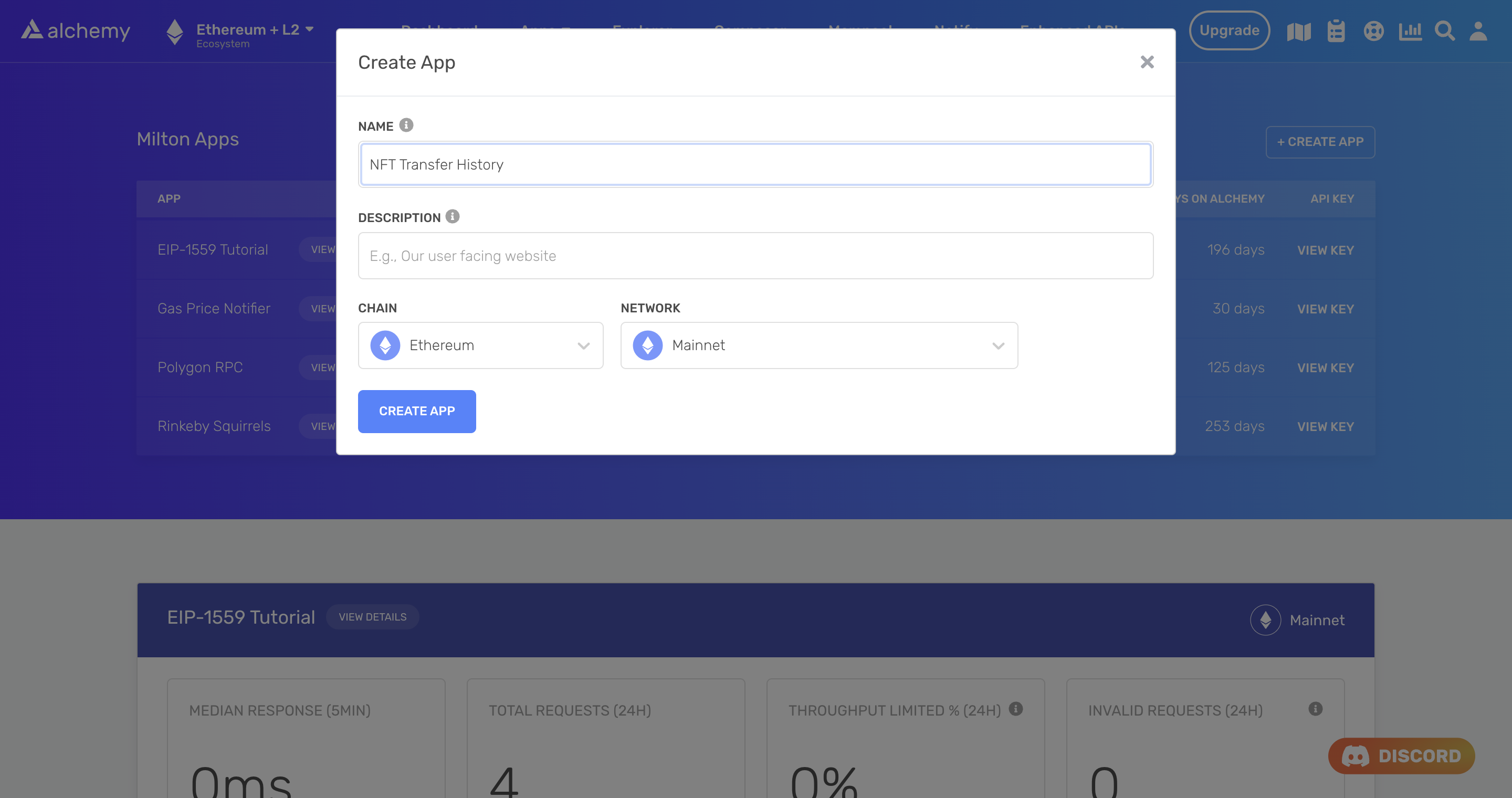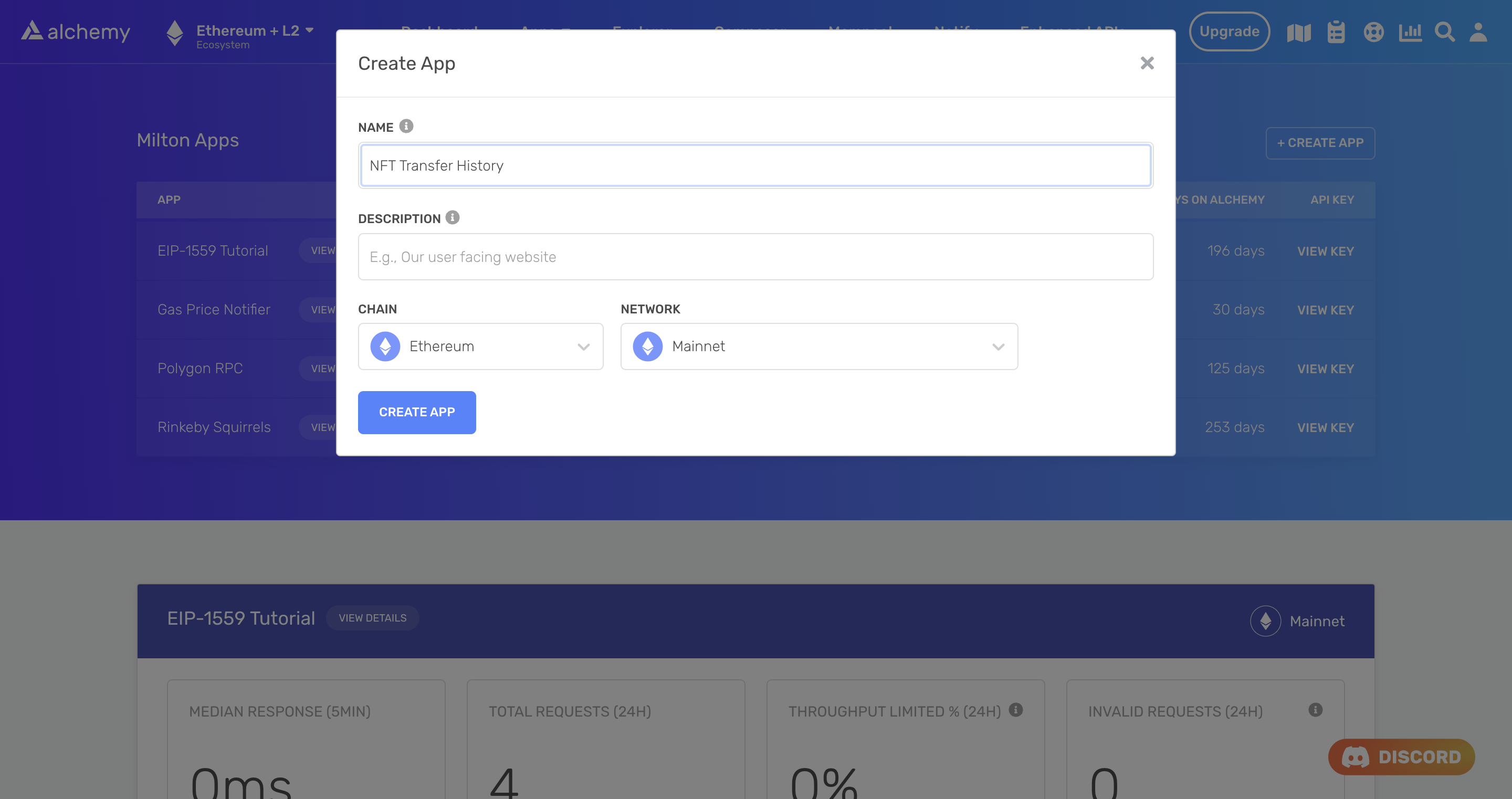How to Get the Transfer History of an NFT
Learn how to trace the ownership history of an NFT using the Alchemy Transfers API
API Endpoint
This tutorial uses the alchemy_getAssetTransfers endpoint.
If you just need the script for this tutorial refer to the below Recipe or continue reading for more
If you're building a marketplace like OpenSea, an NFT price estimator, or an analytics platform like Nansen, chances are you will want to trace the ownership history of an NFT and display this information to your customers.

An example of BAYC #5672's transfer history
There are a couple of ways to trace the ownership history of an NFT. One way is to parse all transactions of the blockchain since the genesis block, filter for transactions associated with the NFT, then display that information in a human-readable format. Typically, this method involves a massive amount of engineering resources and time.
A more straightforward way is to use Alchemy's Transfers API and bypass the effort required to ingest and analyze an entire blockchain. This article details how to use the Alchemy Transfer API to get the ownership and transfer history of an NFT.
Creating the NFT Transfer History Script
In this tutorial, we will write a script in Node that retrieves the transfer history of an NFT in the Bored Ape Yacht Club collection. We will achieve this by using Alchemy and the Transfers API.

Prerequisites
Before you begin the steps in this tutorial, ensure you complete the following steps:
- Install both Node.js (> 14) and npm on your local machine.
- If you do not have node or npm installed, you can find instructions to install them How to Set Up Core Web3 Developer Tools. To check your Node version, run the following command in your terminal:
node -v
Step 1: Create an Alchemy app
To create an Alchemy app, sign up for a free account and:
- From Alchemy's dashboard, hover over the Apps drop-down menu and choose Create App.
- Fill out the fields in the Create App form:
- Provide a Name and Description for your app.
- For Chain, select Ethereum.
- For Network select Mainnet.
- Click the Create App button.

Creating an app on the Alchemy Dashboard
Once you have created your app, click on your app's View Key button in the dashboard and save the API KEY. We will use this later.
Step 2: Create a Node project
Let's create an empty repository and install all node dependencies. We recommend using the Alchemy Quickstart Guide to make requests to the Transfers API. However, you can also use the axios or fetch libraries. We provide code samples for all three methods. Run the following commands in your terminal:
mkdir nft-transfers && cd nft-transfers
npm init -y
npm install --save alchemy-sdk
touch main.js
mkdir nft-transfers && cd nft-transfers
npm init -y
npm install --save axios web3
touch main.js
mkdir nft-transfers && cd nft-transfers
npm init -y
npm install --save web3
touch main.js
This creates a repository named nft-transfers with all the files and dependencies we need. Open this repo in your preferred code editor (e.g., VS Code). We will write the remainder of our code in the main.js file.
Step 3: Get the transfer history of a particular NFT
To get the transfer history of a particular NFT, we will use the getAssetTransfers function. This function accepts several required and optional arguments. In our example, we will use the following arguments:
fromBlock: The block to start tracing transfer history from. We will set this to the genesis block or0x0.contractAddresses: A list of contract addresses we want to trace transfer history for. In our case, this will be just the main BAYC contract.category: A list of categories of transactions we want to track. In our case, we only want to trackerc721andtokentransactions.excludeZeroValue: A Boolean flag to exclude transfers with zero value. We will set this tofalsesince we are interested in all transfers.
The function also takes in other arguments that allow us to filter transactions by origin wallet address, destination wallet address, etc. For the list of parameters, check out the Transfers API
By default, Alchemy returns only the first 1000 transactions recorded for that particular smart contract. If you want to get subsequent transactions, you need to set the pageKey argument.
Since the BAYC contract has hundreds of thousands of transactions, we will focus on only the first 1000 for the sake of simplicity.
Add the following code to the main.js file, being sure to use your Alchemy API key:
// Setup: npm install alchemy-sdk
import { Alchemy, Network, fromHex } from "alchemy-sdk";
const config = {
apiKey: "<-- ALCHEMY APP API KEY -->",
network: Network.ETH_MAINNET,
};
const alchemy = new Alchemy(config);
const main = async () => {
// Contract address
const address = ["0xBC4CA0EdA7647A8aB7C2061c2E118A18a936f13D"];
// Get all NFTs
const response = await alchemy.core.getAssetTransfers({
fromBlock: "0x0",
contractAddresses: address,
category: ["erc721"],
excludeZeroValue: false,
});
// Set NFT ID
const nftId = 3;
// Get transactions for the NFT
let txns = response.transfers.filter(
(txn) => fromHex(txn.erc721TokenId) === nftId
);
console.log(txns);
};
const runMain = async () => {
try {
await main();
process.exit(0);
} catch (error) {
console.log(error);
process.exit(1);
}
};
runMain();
//main.js
const axios = require('axios')
const web3 = require('web3')
// BAYC contract address
const address =
['0xBC4CA0EdA7647A8aB7C2061c2E118A18a936f13D']
// NFT Token ID
const nftId = 3
// Alchemy API key
const apiKey = '<-- ALCHEMY APP API KEY -->';
var data = JSON.stringify({
"jsonrpc": "2.0",
"id": 0,
"method": "alchemy_getAssetTransfers",
"params": [
{
"fromBlock": "0x0",
"contractAddresses": address,
"excludeZeroValue": false,
"category": ["erc721"],
}
]
});
var config = {
method: 'post',
url: `https://eth-mainnet.g.alchemy.com/v2/${apiKey}`,
headers: {
'Content-Type': 'application/json'
},
data : data
};
axios(config)
.then(function (response) {
// Get transactions for the NFT
txns = response['data']['result']['transfers'].filter(
txn => web3.utils.hexToNumber(txn['erc721TokenId']) === nftId)
console.log(txns)
})
.catch(function (error) {
console.log(error);
});
//main.js
import fetch from 'node-fetch';
import web3 from 'web3';
// BAYC contract address
const address =
['0xBC4CA0EdA7647A8aB7C2061c2E118A18a936f13D']
// NFT Token ID
const tokenId = 3
// Alchemy API key
const apiKey = '<-- ALCHEMY APP API KEY -->';
var myHeaders = new Headers();
myHeaders.append("Content-Type", "application/json");
var raw = JSON.stringify({
"jsonrpc": "2.0",
"id": 0,
"method": "alchemy_getAssetTransfers",
"params": [
{
"fromBlock": "0x0",
"contractAddresses": address,
"excludeZeroValue": false,
"category": ["erc721"],
}
]
});
var requestOptions = {
method: 'POST',
headers: myHeaders,
body: raw,
redirect: 'follow'
};
fetch(`https://eth-mainnet.g.alchemy.com/v2/${apiKey}`, requestOptions)
.then(response => {
// Get transactions for the NFT
txns = response['data']['result']['transfers'].filter(txn => web3.utils.hexToNumber(txn['erc721TokenId']) === nftId)
console.log(txns)
})
.catch(error => console.log('error', error));
Note:
Check out the code comments for more information about what the function achieves.
Run this script by typing the following command in your terminal:
node main.js
If successful, you should see output that looks something like this:
[
{
blockNum: '0xbb933a',
hash: '0xcfb197f62ec5c7f0e71a11ec0c4a0e394a3aa41db5386e85526f86c84b3f2796',
from: '0x0000000000000000000000000000000000000000',
to: '0xaba7161a7fb69c88e16ed9f455ce62b791ee4d03',
value: null,
erc721TokenId: '0x0000000000000000000000000000000000000000000000000000000000000003',
erc1155Metadata: null,
tokenId: '0x0000000000000000000000000000000000000000000000000000000000000003',
asset: 'BAYC',
category: 'erc721',
rawContract: {
value: null,
address: '0xbc4ca0eda7647a8ab7c2061c2e118a18a936f13d',
decimal: null
}
},
{
blockNum: '0xbc5b5a',
hash: '0x3c6c5ea49f24ba9fedd8c2de7016564f124ce562cf719581efd484d36e4e5b10',
from: '0xaba7161a7fb69c88e16ed9f455ce62b791ee4d03',
to: '0x03546b22bc80b3e6b64c4445963d981250267a68',
value: null,
erc721TokenId: '0x0000000000000000000000000000000000000000000000000000000000000003',
erc1155Metadata: null,
tokenId: '0x0000000000000000000000000000000000000000000000000000000000000003',
asset: 'BAYC',
category: 'erc721',
rawContract: {
value: null,
address: '0xbc4ca0eda7647a8ab7c2061c2e118a18a936f13d',
decimal: null
}
}
]
You can see that the BAYC #3 was minted to address 0xab..03 and then transferred from 0xab..03 to 0x03..68.
Conclusion
Congratulations! You just used the Alchemy Transfer's API to retrieve the transfer history for BAYC #3! You can adapt this script to retrieve the history for other NFTs in a collection or even for collections on other blockchain networks (e.g., Polygon).
If you enjoyed this tutorial about how to trace the transfer history of NFTs, tweet us at @AlchemyPlatform and give us a shoutout!
Don't forget to join our Discord server to meet other blockchain devs, builders, and entrepreneurs!
Ready to start using the Alchemy NFT API? Create a free Alchemy account and do share your project with us!
Updated almost 2 years ago
